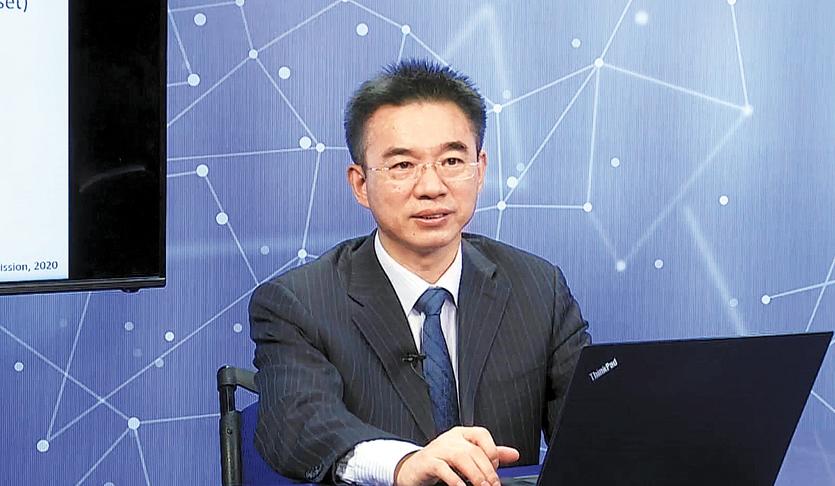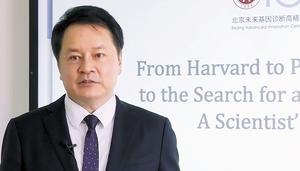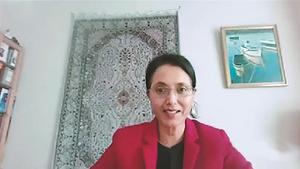Vision China event highlights benefits of open communication among experts in field

Editor’s note: Vision China was launched in 2018 by China Daily. This latest edition was broadcast on multiple media platforms on May 17 to a global audience.
 Wu Zunyou, chief epidemiologist at the Chinese Center for Disease Control and Prevention, has been involved in HIV/AIDS research and public health programs for over 30 years. Wu worked on SARS in 2003 and joined efforts in controlling COVID-19 in January. (PHOTO PROVIDED TO CHINA DAILY)
Wu Zunyou, chief epidemiologist at the Chinese Center for Disease Control and Prevention, has been involved in HIV/AIDS research and public health programs for over 30 years. Wu worked on SARS in 2003 and joined efforts in controlling COVID-19 in January. (PHOTO PROVIDED TO CHINA DAILY)
Quick response to disease challenge a ‘world record’
Wang Xiaodong
China’s scientific progress led to fast identification of new virus and development of testing kits
A swift response to the COVID-19 outbreak played an important role in the containment of the epidemic in China, while international cooperation is needed to bring it under control globally, a top Chinese epidemiologist said.
“China responded very fast. It took only a week from issuing the first epidemiological alert to identifying the pathogen for the outbreak, and it only took another four days to develop the first test kits for the coronavirus,” Wu Zunyou said. “It created a world record in terms of response to a new infectious disease.”
The first alert on the outbreak was issued at the end of December by authorities in Wuhan, Hubei province, and on Jan 7, the Chinese Center for Disease Control and Prevention, or China CDC, successfully isolated the novel coronavirus, Wu said.
Days later, China shared the genetic sequence of the virus with the world. By Jan 20, COVID-19 was listed as a notifiable infectious disease under the most strict management in China, similar to plague and severe acute respiratory syndrome.
“Improved scientific and technological development in China in recent years has greatly contributed to the quick response to the disease, making quick identification of the new virus and development of testing kits for diagnosis,” Wu said.
“We have seen big progress in this aspect compared with the SARS outbreak in China 17 years ago.”
Following the COVID-19 outbreak, China quickly adopted a number of measures for epidemic control and prevention, including universal use of masks and social distancing measures, strict isolation of cases and contact tracing of close contacts of confirmed cases, which in combination had effectively contained the virus, he added.
Considering the severity of novel coronavirus pneumonia, such stringent measures were necessary for epidemic control, Wu said.
For example, patients with the virus can be infectious one or two days before they show symptoms, while SARS patients could only infect others at least five days after they started to display symptoms, which made it important for seemingly healthy people to wear masks to prevent transmission of the virus, he said.
With the major epidemic brought under control in China, the country now faces tremendous pressure from imported cases, which have constituted the majority of cases reported recently, Wu said.
“Controlling the COVID-19 outbreak is not for one country,” he said. “It is a global endeavor.”
wangxiaodong@chinadaily.com.cn
 Sunney Xie is internationally renowned for his pioneering work in the field of single-molecule biophysical chemistry and its applications in biology. He is currently a professor at Peking University, where he is dean of Sciences and heads the Beijing Advanced Innovation Center for Genomics and the Biomedical Pioneering Innovation Center. (PHOTO PROVIDED TO CHINA DAILY)
Sunney Xie is internationally renowned for his pioneering work in the field of single-molecule biophysical chemistry and its applications in biology. He is currently a professor at Peking University, where he is dean of Sciences and heads the Beijing Advanced Innovation Center for Genomics and the Biomedical Pioneering Innovation Center. (PHOTO PROVIDED TO CHINA DAILY)
Pandemic shows research should face no borders
Wang Xiaoyu
Scientist says Sino-US collaboration benefits both countries, whole world
China-US scientific collaboration will bring enormous benefits for the world, including bolstering progress in finding a cure for the novel coronavirus, said Sunney Xie.
The pandemic sweeping the globe has shown the need for united, international action in fighting a common enemy, Xie said at the latest Vision China event on May 17.
This had been expressed in medical aid, voluntary work, generous donations, web seminars and collaborative research. “The virus knows no borders, and the same goes for our fight against it,” said Xie, who is Chinese American.
Xie, who also heads two state-of-the-art research centers of Peking University, is now leading research into treatments for COVID-19, tapping into his field of expertise in single-cell genomics.
With the latest technology of single-cell genomics, Xie’s team has accelerated the discovery of 14 neutralizing antibodies produced by immune systems of recovered patients — an otherwise time-consuming process that was comparable to “looking for a needle in a haystack”.
“The best of them will be developed into a drug to cure COVID-19. It can also be used to provide short-term protection for a patient’s family or medical staff,” Xie said.
Following encouraging results from animal tests that show a dramatic reduction of the viral load in infected mice and effective immunity generated in uninfected mice, he said preparations for further clinical trials are underway.
“At present, there are few COVID-19 patients in China, so our clinical trials will be conducted abroad. If proven successful, we would certainly want it to benefit the whole world … because humanity is above all,” he said.
Xie said in a commentary titled “Diseases Have No Borders. Neither Should Research”, published in the journal Cell in September, that science should transcend politics and global scientists must collaborate.
In 2018, he returned to his alma mater, Peking University, after teaching at Harvard University in the United States for two decades.
“Never did I expect that only six days after I relocated to Peking University, the United States would implement the first China-specific tariffs,” he said.
“Soon after, the National Institute of Health ordered hundreds of US academic institutions to investigate their scientists who conducted collaborative research in China. This led to the closing of several laboratories and hardships for many well-established researchers in the US.”
One of his most significant achievements during his time at Harvard, the development of a method to halt genetic diseases in embryos, stemmed from collaborating with colleagues in China. His partners included Qiao Jie and Tang Fuchou, both professors at Peking University. Thanks to this technology, more than 1,000 babies were born free from the genetic disorders their parents carried in China.
“We did not do the research to serve China alone. There are thousands of monogenetic diseases in the world, suffered by people of all ethnic groups. I am delighted that this technology has since been adopted in the United States and worldwide,” Xie said.
He said his experience is an example of “how Sino-US collaboration benefits both countries and, ultimately, the whole world”.
Xie recalled the support and warmth that he received from his foreign professors when he first arrived in the United States in 1985 as a PhD candidate at the University of California, San Diego, and later from his colleagues at Harvard where he went on to become a tenured professor.
Now back in his home country, Xie said he continued to do impactful research by collaborating with US researchers.
“Being scientists, we all believe that it is science, not politics, that will save mankind from the disaster of COVID-19 and other disasters yet to come,” he said. “Diseases have no borders. Neither does research. Nor should Humanity.”
 Shamila Nair-Bedouelle, assistant director-general for natural sciences at UNESCO, has built an international career as a research scientist and has profound experience in managing international programs. Before joining UNESCO, she headed the United Nations Environment Programme’s OzonAction Branch from 2012. (PHOTO PROVIDED TO CHINA DAILY)
Shamila Nair-Bedouelle, assistant director-general for natural sciences at UNESCO, has built an international career as a research scientist and has profound experience in managing international programs. Before joining UNESCO, she headed the United Nations Environment Programme’s OzonAction Branch from 2012. (PHOTO PROVIDED TO CHINA DAILY)
China enables data sharing
Zhang Yangfei
Today’s problems call for international scientific collaboration, UN official says
The COVID-19 pandemic has demonstrated an increasing need to make scientific data and information more accessible across the world and China has been an active contributor to answering that need, an UN official said.
Shamila Nair-Bedouelle told the Vision China event on May 17 that the COVID-19 crisis had shown a “unique and productive” international solidarity among scientists across the globe, who had been exchanging scientific and technological data beyond country borders. Nair-Bedouelle said Chinese scientists sequenced the genome of the novel coronavirus very early and posted it online in a bid to promote open science and scientific collaboration around the world.
The sequencing by the Chinese scientists was “extremely important” because it enabled scientists in Germany and other countries to develop a screening test “which could be used by the World Health Organization and help many governments to screen for this particular pandemic”, she added.
Nair-Bedouelle said UNESCO especially welcomed the open science coronavirus platform set up by Chinese scientists and looked forward to working with them to continue the sharing of scientific and technological data.
“The initiative is really in the spirit of making science more accessible, more connected to societal needs and promoting equal opportunities for people and scientists across the world,” she said, adding that the creation and transfer of scientific knowledge is critical to building and sustaining social and economic welfare in the global economy.
Nair-Bedouelle stressed the importance of scientific collaboration and sharing scientific data and information around the world as it not only helped management of the COVID-19 crisis but also preparations for future unknown global threats.
She said there is an increasing number of problems today that call for international scientific collaboration, including the COVID-19 pandemic.
“Achieving the sustainable development goals for a prosperous and peaceful world will require access to scientific information between the peoples and the nations of the world,” Nair-Bedouelle said. “But it will also require a fundamental change in the relationships between scientists.”
zhangyangfei@chinadaily.com.cn
 Denis Depoux is the global managing director of Roland Berger, an international consulting firm headquartered in Munich, Germany. He joined Roland Berger in 2001, focusing on the energy and environmental sectors. Depoux has been actively supporting the company’s China operations since 2007 and became the company’s managing director this year. (PHOTO PROVIDED TO CHINA DAILY)
Denis Depoux is the global managing director of Roland Berger, an international consulting firm headquartered in Munich, Germany. He joined Roland Berger in 2001, focusing on the energy and environmental sectors. Depoux has been actively supporting the company’s China operations since 2007 and became the company’s managing director this year. (PHOTO PROVIDED TO CHINA DAILY)
‘Innovation magic’ comes to the fore in virus fight
Zhang Yangfei
China’s accelerated deployment of tech solutions wins praise
China has been flexible and speedy in using technology and innovation to respond to the novel coronavirus crisis, said Denis Depoux.
Chinese technologies in areas such as connectivity and mobile applications development played a big role in powering the fight against COVID-19, he said at the Vision China event on May 17.
The aftermath of the pandemic, which has included travel restrictions, economic and social uncertainty and business disruption, has also stimulated digitization and ideas to minimize physical contact. More new ideas will be needed to resume “normal order”, he said.
Depoux said China had used its “innovation magic” to cope with the outbreak.
As the cradle of design thinking and inventing practical solutions to problems, China accelerated innovation during the crisis. Depoux said this was nothing new as similar efforts were made in 2003 in the fight against the severe acute respiratory syndrome outbreak. For example, Taobao, the country’s biggest e-commerce platform, started to grow rapidly at that time.
Depoux said Chinese innovation is about “connection, flexibility, concrete tooling, speed, churn and growth” and its success was driven by several key players.
To spur innovation, Chinese governments at all levels have provided funds and incentives, made data available and eased administrative procedures for production of healthcare equipment, protective gear and new drugs.
Internet giants also accepted their responsibilities and created applications, such as the Suishenban health code app, to facilitate services for residents. “The internet giants had the ability to provide not only their traditional services, but to ‘connect the dots’ … to use their supply chains and ability to connect companies and individuals to fight the crisis,” he said.
Businesses such as telecommunications company Huawei and Mavic drones repurposed their delivery and service robots to put them into use in hospitals or contactless elevator systems. Small and medium-sized enterprises, as well as startups, were also innovative in the provision of services such as registration, travel history monitoring, healthcare system administration and insurance.
Depoux said all the innovative measures, whether powered by low or cutting-edge technologies, proved to be useful, smart, agile and efficient. Telecommunication companies, for example, used simple technology to make tracking travel history possible by simply scanning a QR code. SenseTime, a leading artificial intelligence company, developed a solution to check people’s temperatures and make sure they wear masks properly. Depoux called it a “very interesting face-recognition development”, considering people were wearing masks.
zhangyangfei@chinadaily.com.cn


